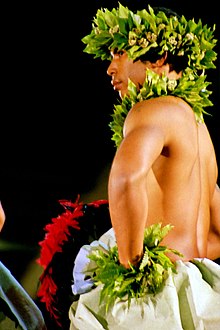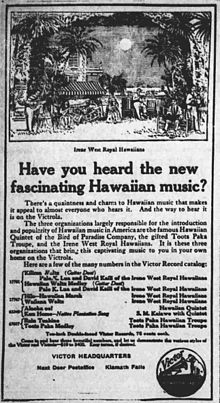Music of Hawaii
April's Aloha Week is a popular tourist attraction, as is the Moloka'i Music Festival held around Labor Day.[5] The annual Manoa Jazz & Heritage Festival takes place in early autumn at the Andrews Amphitheatre on the University of Hawaiʻi at Mānoa campus.[10] Other venues for Hawaiian music on Oahu include the Waikiki Shell, an establishment used primarily for concerts and entertainment purposes.Traditional Hawaiian music and dance was functional, used to express praise, communicate genealogy and mythology, and accompany games, festivals and other secular events.The Hawaiian language has no word that translates precisely as music, but a diverse vocabulary exists to describe rhythms, instruments, styles and elements of voice production.Hawaiian folk music is simple in melody and rhythm, but is "complex and rich" in the "poetry, accompanying mimetic dance (hula), and subtleties of vocal styles... even in the attenuated forms in which they survive today".Mele chants were governed by strict rules, and were performed in a number of styles include the rapid kepakepa and the enunciate koihonua.From 1778 onward, Hawaii began a period of acculturation with the introduction of numerous styles of European music, including the hymns (himeni) introduced by Protestant missionary choirs.The subsequent period lasted to the beginning of the 20th century, and was marked by the creation of an acculturated yet characteristically Hawaiian modern style, while European instruments spread across the islands.The most frequently told story is that it accompanied the Mexican cowboys (vaqueros) brought by King Kamehameha III in 1832 in order to teach the natives how to control an overpopulation of cattle.In 1903, Albert "Sonny" Cunha composed My Waikiki Mermaid, arguably the first popular hapa haole song (The earliest known hapa haole song, "Eating of the Poi", was published in Ka Buke o na Leo Mele Hawaii...o na Home Hawaii in Honolulu in 1888 [See Kanahele, George S., Hawaiian Music and Musicians pp 71–72]).[20] Slack-key guitar (kī ho`alu in Hawaiian) is a fingerpicked playing style, named for the fact that the strings are most often "slacked" or loosened to create an open (unfingered) chord, either a major chord (the most common is G, which is called "taro patch" tuning) or a major 7th (called a "wahine" tuning).By the time of the Hawaiian Renaissance, though, the example of players such as Auntie Alice Namakelua, Leonard Kwan, Raymond Kane, and Keola Beamer had encouraged the sharing of the tunings and techniques and probably saved the style from extinction.Playing techniques include "hammering-on", "pulling-off", "chimes" (harmonics), and "slides," and these effects frequently mimic the falsettos and vocal breaks common in Hawaiian singing.Hawaiian music in general, which was promoted under the reign of King David Kalakaua as a matter of national pride and cultural revival, drew rhythms from traditional Hawaiian beats and European military marches, and drew its melodies from Christian hymns and the cosmopolitan peoples of the islands (although principally American).In reverse, musicians like Bennie Nawahi began incorporating jazz into his steel guitar, ukulele, and mandolin music, while the Kalama Quartet introduced a style of group falsetto singing.[1] Lani McIntire was another musician who infused a Hawaiian guitar sound into mainstream American popular music through his recordings with Jimmie Rodgers and Bing Crosby.[23] The influx of thousands of American servicemen into Hawaii during World War II created a demand for both popular swing rhythm and country sounds.Beginning in 1945, the Bell Record Company of Honolulu responded to the demand with a series of releases by the western swing band Fiddling Sam and his Hawaiian Buckaroos (led by fiddler Homer H. Spivey, and including Lloyd C. Moore, Tiny Barton, Al Hittle, Calvert Duke, Tolbert E. Stinnett, and Raymond "Blackie" Barnes).[24] According to the Director of Music at Kamehameha from 1926-1947, Miss Laura Brown, "the objectives of the song contest are to build up the repertoire of the best in Hawaiian music for the cultural heritage of any student who attends Kamehameha; to develop leadership, cooperation and good class spirit; and to give students the use of their singing voices and to give them pleasure in singing as a means of expression".The entire program length is around two-two and a half hours, and consists of the oli hoʻokipa (opening chant), pule (prayer), singing Hoʻonani Ka Makua Mau (Doxology), singing Hawaiʻi Ponoʻi (The Hawaiʻi National Anthem), the main program with 10 songs sung by classes singing their co-ed, men, and women songs, Hōʻike (hula half-time exhibition performance), results and awards being presented (Ka Hāʻawi Makana), and ending with the alma mater (Sonʻs of Hawaiʻi).The islands have also produced a number of well-regarded rock, pop, hip hop (na mele paleoleo), dubstep, soul, and reggae performers, and many local musicians in the clubs of Waikiki and Honolulu play outside the various "Hawaiian" genres.The more traditional players included Leland "Atta" Isaacs, Sr., Sonny Chillingworth, Ray Kane, Leonard Kwan, Ledward Ka`apana, Dennis Pavao, while Keola Beamer, and Peter Moon have been more eclectic in their approach.[1] Don Ho (1930–2007), originally from the small Honolulu neighborhood of Kaka'ako, was the most widely known Hawaiian entertainer of the last decades of the 20th century.It has become popular across the world, especially among ethnic groups and races that have been historically oppressed, such as Native Americans, Pacific Islanders, and Australian Aborigines.[citation needed] The band Simplisity has been credited by Quiet Storm Records as originators of the Jawaiian style, while other influences include Walter Aipolani, known as the Father of Hawaiian Reggae.[28] By the end of the 1980s, Jawaiian came to dominate the local music scene, as well as spawning a backlash that the Honolulu Star-Bulletin compared to the "disco sucks" movement of the late 1970s.[citation needed] Notable jazz vocalists in Hawaii, both current and retired include Jimmy Borges, Rachel Gonzales, Azure McCall, Dana Land, Joy Woode, and I. Mihana Souza.[citation needed] They were aboard the Ravenscrag ship under a contract to help out with labor upon the sugar plantations spread throughout the Hawaiian Islands at the time.According to the book `Ohe, by Leilehua Yuen,[citation needed] the instrument was popularized in the 1970s by members of the Beamer family who played it during performances on tour in North America, as well as in the Hawaiian Islands.





Music of Hawaii (album)Music of the United StatesHonolulu Symphony OrchestraRoyal Hawaiian BandMaui Academy of Performing ArtsHawaii Academy of Recording ArtsHawaii Music AwardsFestivalsMerrie Monarch FestivalHawaiihip hopslack-key guitarHollywoodsoundtrackscountry musicsteel guitarcachi cachi musicNative Hawaiian communitychantingdance musicmusic of other Polynesian islandsMerrie Monarch Hula FestivalAloha WeekLabor DayHawaii Convention CenterUniversity of Hawaiʻi at MānoaUniversity of Hawaii at HiloKauai Community College Performing Arts CenterNeal S. Blaisdell CenterHawaii TheatreWindward Community CollegeLeeward Community CollegeHawaii Opera TheatreGuitar and Lute Workshopslack-key guitarsKamaka UkuleleHawaiian languagemelodyrhythmU.S. NavyKahoolawedancinga cappellaaffectionnamingprayersurfinggenealogicalstring instrumentsguitarfalsettoukulelebraguinhahapa haoleVictor Talking Machine CompanyPuerto Rican immigration to HawaiiPuerto RicohurricanessugarcaneplantationWebley Edwardsorchestrabig bandHawaii CallsLani McIntireJohn Kameaaloha AlmeidaSol HoʻopiʻiHawaiian Renaissanceindie rockNa mele paleoleoJawaiianLiliʻuokalaniHawaiian monarchywho wrote many musical worksAloha 'OePrussianHenri BergerKaiserKamehameha VGerman musicHenry Kaleialoha AllenKamehameha IIIcattleMadeiracavaquinho`ukulelelap steel guitar"frying pan"Hapa haole musicDavid KalakauaLili'uokalanibrass bandsJoseph KekukuEnglishRagtimeAlbert "Sonny" CunhaTau MoeAdolf HitlerAuntie Alice NamakeluaLeonard KwanRaymond KaneKeola BeamerpanioloKing David KalakauaBroadwayBird of ParadisePanama–Pacific International ExpositionSan FranciscocountryBennie NawahimandolinNashville soundJimmie RodgersBing Crosbylocal tourismPanama-Pacific ExpositionKamehameha Schoolshula ʻauanahula kahikodubstepreggaeAmerican popular musicGabby PahinuiRy CooderLeland "Atta" Isaacs, Sr.Sonny Chillingworth